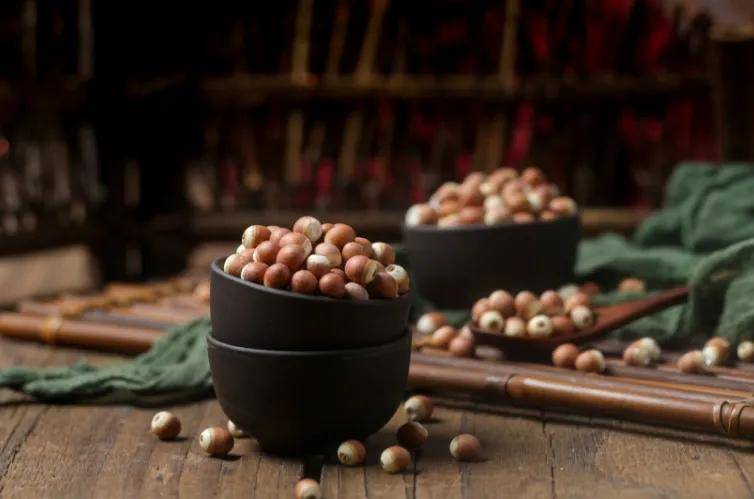Chestnut is one of the top-grade medicinal materials recorded in the “Huangdi Neijing” and is also a commonly used medicinal and edible material.
Chestnuts are white like lotus seeds, small like pearls, and are a kind of aquatic plant. They are known as one of the “Eight Immortals in the Water” and generally grow between ponds and lakes. They resemble a plucked chicken head, with a hard shell on the outside that, when peeled off, reveals shiny little grains inside.
Therefore, chestnuts are also known as chestnut rice or chicken head rice.
Nourishing without being harsh, preventing dryness without being greasy.
Ancient medical books mention that it has the effects of “infants eating it will not age, and the elderly eating it will extend their years.” It has the characteristics of “nourishing without being harsh” and “preventing dryness without being greasy.”
In the novel “Dream of the Red Chamber,” there is a passage mentioning “Qiu Shuangzhai occasionally forms the Begonia Society, Hengwuyuan at night prepares chrysanthemums for inscription,” stating that Jia Baoyu asked someone to send some food to Shi Xiangyun, including two fresh items, one being red water chestnut and the other being chestnuts.
The great Song Dynasty writer Su Dongpo also loved eating chestnuts. Even in old age, Su Dongpo remained healthy, with a ruddy complexion and sharp mind. He studied health extensively and wrote books such as “Su Dongpo’s Health Preservation Essays.”
One of his health preservation methods involved eating chestnuts in a peculiar way:
He would occasionally take a freshly cooked chestnut, put it in his mouth, chew slowly until the mouth was full of fluid, gargle a few times, and then swallow slowly.
He would eat 10-30 chestnuts this way every day, persisting day after day, year after year, unwaveringly.
Of course, Su Dongpo consumed a larger quantity; for ordinary people, eating about seven to eight chestnuts at a time is sufficient.
It is said that Su Dongpo also greatly enjoyed eating “chicken head rice porridge” made from chestnuts, describing it as “porridge that quickly nourishes; after a nap, indescribably wonderful.”
In traditional Chinese medicine, chestnuts have a sweet, astringent, and neutral nature, entering the spleen and kidney meridians, nourishing the spleen, dispelling dampness, and tonifying the kidneys. Its kidney-nourishing effect surpasses that of Chinese yam, its dampness dispelling effect is better than that of adzuki beans, and its calming effect is stronger than lotus seeds. It can be considered a buried and nourishing treasure.
Autumn tends to be dry, and chestnuts can moisten dryness without being cold, making them particularly suitable for consumption in the autumn.
Nourishing the spleen.
Chestnuts, rooted in the muck at the bottom of a river, possess the qualities of earth. Additionally, chestnut flowers are purple, indicating a prevalence of the fire-avoiding qi between heaven and earth, giving them a warm nature.
The growth characteristics of chestnuts determine that they enter the spleen earth, helping to nourish the spleen. This strengthens the digestive ability of the spleen and regulates loose stools caused by spleen deficiency.
In traditional Chinese medicine, the spleen and stomach are considered the foundation of acquired constitution and the source of Qi and blood transformation. Therefore, to have abundant Qi and blood, it is essential to first nurture the spleen and stomach.
Some people feel very full after eating a small amount, suffer from poor digestion, food stagnation, and other issues, which are signs of poor spleen and stomach health.
Some individuals fail to absorb nutrients effectively, leading to diarrhea, a condition known in Chinese medicine as incomplete digestion due to spleen dysfunction.
As chestnuts are quite hard, if they are not cooked thoroughly and become pasty, their effect on tonifying the spleen and stomach will be greatly diminished. Therefore, although chestnuts are good for the spleen and stomach, they should not be consumed in large quantities at once.
Here is a recommended method: take an appropriate amount of chestnuts, fry them until cooked, grind them into powder, take 50 grams of the powder, dissolve it in hot water before consumption. According to personal preference, sesame seeds, peanuts, and walnuts can be added.
Nourishing the kidneys.
In addition to entering the spleen, chestnuts can also enter the kidneys, which can nourish kidney essence.
The “Compendium of Materia Medica: One Hundred Kinds” calls it a “medicine for the spleen and kidneys.” The “New Compilation of Materia Medica” also states that it can “nourish the spleen and consolidate essence.”
As mentioned earlier, the renowned writer Su Dongpo liked to use chestnuts for health maintenance. He consumed chestnuts regularly, remaining healthy, with a ruddy complexion, sharp mind, maintaining a youthful state even in old age.
In traditional Chinese medicine, whether a person appears young or aged is closely related to a specific organ, which is the kidneys.
Chestnuts are indeed an excellent tonic for the kidneys.


